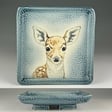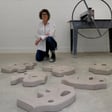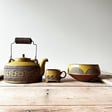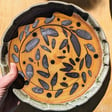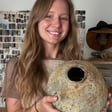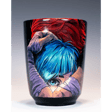Introduction and Interview with Sarah Gromick
00:00:00
Speaker
What if you could turn pottery and make it look like leather? In today's episode, I got to interview Sarah Gromick, and she does exactly that. She turns her pottery and makes it look exactly like leather. It looks super, super cool.
00:00:17
Speaker
Sarah is an amazing potter.
The Teacher-Student Dynamic in Pottery
00:00:19
Speaker
She's also a high school ceramics and art teacher. Along her journey, she talks about why it's so important that she also needs to be a student as well and how this actually helps her with growing her own pottery voice.
Leather-Themed Pottery Techniques
00:00:34
Speaker
Sarah also dives deep into how she creates her leather-themed mugs. And there's so much more on in this episode. Hope you guys enjoy it. But before we get to the episode, have you ever wondered how close you are to actually finding your own unique voice with your pottery?
00:00:49
Speaker
Well, I put together a free four-question quiz to help you discover how close you are to actually finding your voice. If you'd like to take this quiz, go shapingyourpottery.com forward slash quiz and get your results right now.
00:01:02
Speaker
Now, let's get to the interview.
Building Confidence and Community Recognition
00:01:05
Speaker
Sarah, welcome Shaping Your Pottery and share with me what's a failure you have experienced that you believe many potters are heading for? For me, it was always just not being confident in myself.
00:01:16
Speaker
I don't really have a background in ceramics, so I always didn't really believe in my worth. And i feel like a lot of people can relate with that. So I definitely feel like I should have been more confident earlier than I was.
00:01:30
Speaker
What do you think helped you with gaining confidence, especially in your work? Being recognized by other artists. I went to NSECO last year for the first time in Richmond, Virginia.
00:01:41
Speaker
and It was just incredible because like I didn't have any good following then on Instagram. And so it was incredible to have people actually come up to me and be like, oh, I like your work.
00:01:52
Speaker
And that really kind of gave me a boost of, oh, I'm doing something right. Absolutely love that. So tell me the story how you got started making pottery.
Teaching Ceramics and Artistic Growth
00:02:01
Speaker
I actually didn't like pottery for the longest time.
00:02:04
Speaker
I didn't like it in high school. I didn't like it in college. So I graduated as an art education major from Moravian College. So it was basically a dual major, art and education.
00:02:16
Speaker
So I became a teacher as soon as I graduated in 2012. And throughout the years, one of the jobs I acquired was to be a high school art teacher for a medical leave. ah They were like, Hey, we have this position. And at the time I was like, I'll take anything.
00:02:33
Speaker
And they said, well, how about you teach us ceramics? And I'm like, oh good, the one thing I don't know how to do. so So immediately i was like, okay, I'm gonna sign up for a class. It was like a five day quick class over winter break.
00:02:47
Speaker
And I was like, I need to know how to do this. So I learned the wheel and I did like an entire crash course. So I would at least be able to teach the kids one step ahead of where I was.
00:02:58
Speaker
absolutely love that. So you contribute growth as an artist to teaching many different art mediums. Can you tell me more about this? Yeah, so it goes hand in hand with the story I just told.
00:03:11
Speaker
um When I first got out of college, teachers were not in demand. There was a lot of us. And so we were always battling for different jobs and opportunities. So I had to say yes to whatever came my way.
00:03:24
Speaker
And so I've taught... every medium of fine art under the sun, graphic design, drawing, painting, set design, um film survey, just everything.
00:03:36
Speaker
And so i attribute a lot of what I know now to the fact that I had to be so adaptive um to everything. And so I no longer shy away from learning or admitting that I don't know everything. So I would stand in front of my class. I still do this to this day.
00:03:55
Speaker
I stand in front of my high school students and I'll be like, you guys are my guinea pigs. Never taught this before. Have no idea what I'm doing. So let's see how it goes. And they just go along with me. So now I know that it's okay to not know everything.
00:04:10
Speaker
Absolutely love that. Shaping Nation, you don't have to know everything, especially in pottery or especially in art, but the more you try to learn, the better your art becomes.
Social Media Impact and Style Evolution
00:04:18
Speaker
So can you tell me the story how you started making the leather pottery that you make today?
00:04:25
Speaker
So the theme is that everything ties in together. I like to explore and learn new things, and I fell in love with pottery because of the fact that it is just never ending in terms of what you can learn and do with it. So I just never get bored. And so I'm always trying new things.
00:04:43
Speaker
I've had different styles throughout the years and I'm always trying different techniques for decoration. And recently, this actually started December, this past December, um I was working with different clays and I fell in love with Elkhorn from Kentucky Mudworks.
00:05:03
Speaker
And I was using it for a style that I did a lot of Scriffito and like two tones and things. And my mom goes, oh, this is a lot like leather. It feels like leather.
00:05:14
Speaker
You should try doing that. And I was like, oh, okay, I'll try one. And so i tried making one for her for her Christmas present and posted a video of it on Instagram.
00:05:27
Speaker
And I can't even tell you, I went from 3,000 followers on Instagram to like 10,000 followers in a day. It just blew up. It was nuts. And I was like, oh my God, it was like just hitting winter break for school. And I'm like, oh, wow, what do I do now?
00:05:43
Speaker
I thought this was gonna be a one-off. And everyone in the world wants one. So I started exploring more and just kind of followed with it and said, all right, let's let's see how far I can take it.
00:05:57
Speaker
So I just started playing around more with, can i add a can I add a grommet? Can I add a buckle? Can I make it look like the leather is like buttoned up and peeling apart?
00:06:08
Speaker
How far can I go with all of this? And i'm I'm still just scratching the surface because it's only been like a month and a half. What were you feeling when you gained like 6,000 new followers in like a day?
00:06:20
Speaker
Nuts. And my high school students are all like cheering me on. They're in my classroom. I'm like, guys, do you see this? And they're like, miss, this is amazing. So it was just, it was crazy. I'm still in denial because like, I'm just a high schooler teacher. I'm not like some crazy out there potter who knows everything.
00:06:38
Speaker
Like I said, I don't have a background in it. Are you enjoying making these leather pieces? For sure. It's been a lot of fun to learn. The way I approach it is I approach it as if I'm sewing the piece together.
00:06:53
Speaker
So I do treat the clay as if it's fabric and I put it together as if it's fabric. I kind of started doing hand building more than I do throwing. I have always been interested in exploring.
00:07:05
Speaker
I'm a metal teacher. I teach metal and jewelry. And I had no background in that either. My school was like, we want this program, go make it. So I was like, all right, I'll go try.
00:07:19
Speaker
So I like exploring, trying new things and seeing what happens. Absolutely love that shape nation. Again, the more you try new things, more you learn, the better your pottery becomes simply by learning and trying new things. Absolutely love that.
Innovative Pottery Methods and Inspirations
00:07:34
Speaker
So When you're making your leather pots or mugs and pots, you use templates. Why do you use templates instead of just throwing them on the wheel? So I was a wheel thrower for a very long time. I've been doing pottery for eight years and pretty much seven and a half of those was doing the wheel.
00:07:54
Speaker
But over the summer when I was moving to my house, I fell down our basement stairs when I was moving in and I had vertigo for over a month. And I could not do the wheel.
00:08:06
Speaker
So I was like, I'll just try hand building. And so that's how the hand building part started. And then when leather came along and my mom was like, try making it look like leather, templates came into play. Because when you look at when you look at like a bag or you look at a leather boot or if you look at sewing, anything, they all have templates. That's how they're made.
00:08:30
Speaker
You cut out a template and you sew it together and that's how you produce something. So I started doing these templates as well for the exact shapes I wanted. And then each seam was basically the seam of the leather.
00:08:42
Speaker
How do you make your templates? So I make my templates out of craft foam. And there's actually a website. I think it's like TemplateMaker. Oh, I don't remember what the dot. It's like not a typical dot com. It's TemplateMaker.en or dot NL. That's it. TemplateMaker.nl.
00:09:03
Speaker
And so I just started typing into it things that I like. I am big into doing drinkware. I'm always on the move as a teacher. So I like having something cute and fun with me.
00:09:16
Speaker
So my coffee goes with me from my car to my classroom. And so I need things that I can travel with. And so one of the first templates I made was one for like a travel mug. So all of my shapes come from cones and things. It's not really anything brilliant.
00:09:31
Speaker
Yeah. Absolutely love that. Shaping Nation, there's always an easier way to make pottery. And sometimes it's even more fun to do it that way as well. You have to be on the lookout for it. So something interesting that you said is you said, I am driven by the need to learn and explore all there is to ceramics and surface design. Each time I learn new skill, my style changes.
00:09:54
Speaker
Can you tell me more about this? Yeah. So as a teacher, and I think a lot of people can relate to this, I'm a student too. eight feel like i just constantly want to know more and learn more and then be able to share it with my students.
00:10:10
Speaker
Just like I had to adapt and change as a teacher for every different position I got and every different medium I had to teach, my style is very much that way. And so ah because I don't have a background in ceramics and I want to just learn everything there is to know about it, I'm hungry for that information.
00:10:28
Speaker
Every chance I get, whenever anyone says anything to me, about an an opportunity to do a wood firing, a soda firing, go do Raku, do this, that, another thing. I'm like, yes, I'm in.
00:10:40
Speaker
I'm 100% in. I want to learn. i want to know everything there is to know. Partially because I do, I think, have a little bit of imposter syndrome with the like, I want to be telling the correct information, especially with a huge following on Instagram now. I don't want to share bad information.
00:10:58
Speaker
So I'm like, I have to keep going. I have to keep learning. I just like every idea that comes to me. I'm just like, Ooh, that could be cool to try that. Let's go try it. And so then my style evolves just because I'm like, I'm down this rabbit hole right now. And I'll go down another rabbit hole another day.
00:11:15
Speaker
i have friends and family who are always like, hey when you going to make that other thing you used to make again? And I'm like, I don't know. You're to have to wait and see what happens. Absolutely love that. so now can you briefly explain to me how you make one of your leather mugs?
Crafting Leather Mugs
00:11:30
Speaker
Sure. The basics I've learned of hand building all came from other people. I don't know anything special. I learned how to hand build from Sarah Pike and from Naomi Clement. They both do virtual workshops. So I learned from them.
00:11:45
Speaker
So my mug design is fairly similar to Sarah Pike in some ways. I have the basic cone structure template that I use. And then Naomi likes to embrace having seams in her work.
00:12:00
Speaker
And I really picked up on that too. And I was like, that's perfect for the leather. So every time I put a piece together, i am making sure that all of those seams are embraced and shown. And I really kind of accent and highlight them, especially when I add the red iron oxide later.
00:12:17
Speaker
So I build the piece and then I have what's called a fine line applicator. It's a 20 gauge and I roll the holes into my piece and then each single stitch I will draw with my little applicator.
00:12:34
Speaker
And so my hand starts to cramp after a while. And then I've gotten faster at adding handles and things, but basically I hand stitch everything. quote unquote, with slip trailing.
00:12:45
Speaker
And then once it's fired through the bisque fire, i will stain it with iron red oxide and I'll wipe it away to make sure that none of my stitches are stained and they're all white.
00:12:56
Speaker
And then I'll put a borax wash on it afterwards. And that's what gives me the fun speckling aged look. And then I'll do a cone five, six firing afterwards. How did you come across as borax wash?
00:13:11
Speaker
So this is like a big thing right now. Everyone's like playing around with it, cool kid thing. um So there was a couple of artists that I chat with and follow on Instagram who were trying it.
00:13:22
Speaker
You just talked with Adam Miller not that long ago. He was trying it out and I was poking his brain a little bit, asking what he was doing. So I stumbled upon it because of him and because oh, there was an article in Ceramics Monthly Oh my gosh, I don't want to ruin her name, but there was a ah young woman who does it on her pieces that she pinches and she uses Tara's Sidge and she puts it on top of her Tara's Sidge.
00:13:52
Speaker
And so she put it out there as a recipe that she uses. um So it was just a lot of research is how I stumbled upon the borax. And even so it's really funny you bring that up because literally today on Instagram, I posted a video everyone's blowing it up like, hey, what is this? What's this? So I don't even know all the answers. I actually wrote in to Matt Katz to ask him if he could clarify like, is Borax safe? Is Borax food safe? what What's the melting temperature? Please tell me more about this so I don't give incorrect information.
00:14:26
Speaker
Yeah, it's the first time I've heard Borax wash. That's why i was interested about it. It seems useful. It's great for doing surfaces that aren't glazed.
00:14:37
Speaker
and You don't use it with glaze normally in terms of getting the antique defect. Borax is my understanding, again, not an expert, but my understanding is it's a flux when it's in glazes. And so it is in glazes sometimes, but the way I use it is on a surface that's unglazed.
00:14:56
Speaker
Very interesting. might have to give that a try.
Exploration and Experimentation in Pottery
00:14:58
Speaker
so Let's talk about discovering your voice. Can you tell me about the moment when you knew you were heading in the right direction with your pottery?
00:15:07
Speaker
For me, i don't know. i don't really have a single voice, right? I do many different styles. I went from silk screening to scafito and like water etching.
00:15:20
Speaker
Now I'm onto the leather. So for me, I think my voice is, it comes from my background of I am an artist, always have been. I was dyslexic.
00:15:31
Speaker
Well, I am dyslexic, but in in elementary school, it really affected me. And so art was kind of my getaway. So the ability to just be able to try things and express myself and just keep learning is, I think, my voice, is the fact that I will always experiment and I'm always willing to try something new.
00:15:53
Speaker
Absolutely love that. Shape Nation, your voice doesn't just have to be you one simple thing. it continues to evolve over time. And the more you learn, the more your pottery is going to evolve.
00:16:03
Speaker
Absolutely love that. So now, what would you say has been your biggest obstacle when it's getting closer to finding your own voice? So something I've noticed over the years because of the way that I learned, which was through local art studios, is not every local art studio has a good background foundation of information.
00:16:26
Speaker
It was a struggle to know correct techniques to know what is safe, what's not safe, what's a pinhole, what's this, that, and another thing, what's crawling, is this under-fired, is this over-fired?
00:16:39
Speaker
A lot of studios don't teach the technical and the science behind pottery. It's just kind of like a, let's make things and they look pretty. And so I really struggled to get that information because it was one of those things where i didn't know that I didn't know.
00:16:57
Speaker
And so i even would go out and sell my pieces and I'm not sure that I should have been doing that at that point. So that was my biggest struggle, just realizing how little I knew and then informing myself about it.
00:17:12
Speaker
What is something you wish you do earlier that helped you with getting closer to your own style? I wish I knew there weren't so many rules that I had put in place. So I learned a specific way from a specific person and I felt like that was what pottery was.
00:17:29
Speaker
And I wish I had figured it out sooner that once you know the rules, it's like drawing cartooning. Once you know how to draw the body realistically, then you can manipulate and change all the different aspects to make it what you want to in your style in your cartoon.
00:17:46
Speaker
So I just... I knew the general and I knew putting a glaze on is pretty, but I didn't realize how far I could push it away from that.
00:17:57
Speaker
And I wish I had started experimenting sooner than I did. When did you start breaking away from these rules that you set upon yourself? It wasn't until I left that studio. Like I said, certain studios, they just don't have a lot of information, but kind of like act like they do.
00:18:14
Speaker
So I left that studio and that was oh right before the pandemic. so So
Embracing Mistakes and Learning
00:18:23
Speaker
2020, 2021. And as soon as I did and started to see other teachers and I started to look around at other places and thank God for the internet because Instagram was major to me.
00:18:35
Speaker
As soon as I started to do all of that kind of just looking around, I was like, oh, wow, there's a way bigger field to try here. Like I remember one of the first people I followed was Katie Miller.
00:18:49
Speaker
And I was like, whoa, this is so cool with her silk screening and her monoprinting and all that kind of stuff. And I was like, I want to try that. And then I was doomed after that because then I just went down every rabbit hole I could find.
00:19:02
Speaker
My mom and my friends get really mad at me. I'll start messaging them at like 4 a.m. Hey, I have a great idea. what do you think of this? Do you know what this is? Like I have a friend who just opened a ceramic studio in Hillsborough, New Jersey, which is near me.
00:19:17
Speaker
And I'm constantly poking her brain. I'm like, hey, want to try this? You have this information. Can you teach me this? Absolutely love that. Shaping Nation, the only rules you have are the rules you have on yourself for pottery. But when you learn to start breaking those rules, pottery becomes more free and you have more chances to learn as well.
00:19:36
Speaker
Absolutely love that. So now what advice would you give to someone looking and discover their own unique voice about their pottery? Try everything. Just go and try it. Don't be afraid that it's, I've had explosions. I've had things melt. I've had glazes go horribly wrong.
00:19:53
Speaker
Just go and try and see how it comes out and take notes and learn from it. I have a notebook that I keep with me. You can look through my notebook and see the research from all of the different mediums and things that I've done.
00:20:09
Speaker
And I just am constantly referring to it. now I'm taking multiple pieces of it and putting it all together. So just try, ask questions.
00:20:21
Speaker
Don't be afraid to reach out to the people on Instagram. I have people who I was like, oh my God, you're way too famous for me to ever speak to. And they were like, please, please speak to me.
00:20:32
Speaker
Ask me questions. The ceramic like world just seems to be so kind And they're willing to share as long as it's not like some crazy secret. I definitely agree. I find that the ceramics community is very open to just answering any question pretty much.
00:20:50
Speaker
Yep. So, Sarah, it has been wonderful chatting today. And as we come to a close here, what is one thing you want to hammer home with my listeners today?
Community and Diversity in Ceramics
00:20:59
Speaker
It's a unique field. Ceramics is just incredible in the terms of, it's not like drawing where you draw something and you get it.
00:21:06
Speaker
and There's only so many techniques you can learn of drawing. Ceramics is science, it's sculpture, it's throwing on the wheel. There's so many aspects to it. And so enjoy the exploration of all the different things, the different firings, the different techniques.
00:21:24
Speaker
And then meet the people. That's what's really been great for me is going to different studios and different workshops and different things. That's how I've made friends. That's how I've made lifelong friends that I now go and work at their beautiful studio that they opened.
00:21:41
Speaker
So it's a great way to learn. Some excellent parting words, Sarah. It's been wonderful chatting you today.
Conclusion and Social Media Promotion
00:21:48
Speaker
Where can my listeners go and learn more about you? You can follow me on Instagram at Sarah Catherine Clay, and that's my website too.
00:21:56
Speaker
Hey, thanks for listening to this episode of Shaping Your Pottery with Nick Torres. If you want to discover how close you are to actually discovering your own unique voice with your pottery, I put together a free four-question quiz. It's very short.
00:22:11
Speaker
It takes 30 seconds for you to take. If you will want to know how close you are to finding your own unique voice, go to shapingyourpottery.com forward slash quiz, or you can simply go to shapingyourpottery.com and it'll be right there at the top.
00:22:25
Speaker
I hope you guys enjoyed this episode, and I'll see you guys next time.


